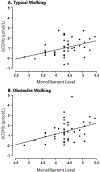Somatosensory impairment of the feet is associated with higher activation of prefrontal cortex during walking in older adults
- PMID: 35644417
- PMCID: PMC9892701
- DOI: 10.1016/j.exger.2022.111845
Somatosensory impairment of the feet is associated with higher activation of prefrontal cortex during walking in older adults
Abstract
Background: Over-activation of prefrontal cortex during walking has been reported in older adults versus young adults. Heighted activity in prefrontal cortex suggests a shift toward an executive control strategy to control walking. A potential contributing factor is degraded functioning of pattern-generating locomotor circuits in the central nervous system that are important to walking coordination. Somatosensory information is a crucial input to these circuits, so age-related impairment of somatosensation would be expected to compromise the neural control of walking. The present study tested the hypothesis that poorer somatosensation in the feet of older adults will be associated with greater recruitment of the prefrontal cortex during walking. This study also examines the extent to which somatosensory function and prefrontal activity are associated with performance on walking and balance assessments.
Methods: Forty seven older adults (age 74.6 ± 6.8 years; 32 female) participated in walking assessments (typical walking and obstacle negotiation) and Berg Balance Test. During walking, prefrontal activity was measured with functional near infrared spectroscopy (fNIRS). Participants also underwent somatosensory testing with Semmes-Weinstein monofilaments.
Results: The primary findings is that worse somatosensory monofilament level was associated with greater prefrontal cortical activity during typical walking (r = 0.38, p = 0.008) and obstacle negotiation (r = 0.40, p = 0.006). For the obstacle negotiation task, greater prefrontal activity was associated with faster walking speed (p = 0.004). Poorer somatosensation was associated with slower typical walking speed (p = 0.07) and obstacles walking speed (p < 0.001), as well as poorer balance scores (p = 0.03).
Conclusions: The study findings are consistent with a compensation strategy of recruiting prefrontal/executive control resources to overcome loss of somatosensory input to the central nervous system. Future research should further establish the mechanisms by which somatosensory impairments are linked to the neural control and performance of walking tasks, as well as develop intervention approaches.
Keywords: Aging; Balance; Brain; Gait; Sensory.
Published by Elsevier Inc.
Conflict of interest statement
Figures


Similar articles
-
Prefrontal over-activation during walking in people with mobility deficits: Interpretation and functional implications.Hum Mov Sci. 2018 Jun;59:46-55. doi: 10.1016/j.humov.2018.03.010. Epub 2018 Mar 29. Hum Mov Sci. 2018. PMID: 29604488 Free PMC article.
-
Increased cortical activation and enhanced functional connectivity in the prefrontal cortex ensure dynamic postural balance during dual-task obstacle negotiation in the older adults: A fNIRS study.Brain Cogn. 2022 Nov;163:105904. doi: 10.1016/j.bandc.2022.105904. Epub 2022 Sep 2. Brain Cogn. 2022. PMID: 36063567
-
Enhanced somatosensory feedback reduces prefrontal cortical activity during walking in older adults.J Gerontol A Biol Sci Med Sci. 2014 Nov;69(11):1422-8. doi: 10.1093/gerona/glu125. Epub 2014 Aug 11. J Gerontol A Biol Sci Med Sci. 2014. PMID: 25112494 Free PMC article.
-
Cortical activity during walking and balance tasks in older adults and in people with Parkinson's disease: A structured review.Maturitas. 2018 Jul;113:53-72. doi: 10.1016/j.maturitas.2018.04.011. Epub 2018 Apr 25. Maturitas. 2018. PMID: 29903649 Free PMC article. Review.
-
Compromised prefrontal structure and function are associated with slower walking in older adults.Neuroimage Clin. 2018 Aug 10;20:620-626. doi: 10.1016/j.nicl.2018.08.017. eCollection 2018. Neuroimage Clin. 2018. PMID: 30191124 Free PMC article. Review.
Cited by
-
High-Definition Trans-Spinal Current Stimulation Improves Balance and Somatosensory Control: A Randomised, Placebo-Controlled Trial.Biomedicines. 2024 Oct 18;12(10):2379. doi: 10.3390/biomedicines12102379. Biomedicines. 2024. PMID: 39457691 Free PMC article.
References
-
- Reuter-Lorenz PA, Cappell KA. Neurocognitive Aging and the Compensation Hypothesis. Current Directions in Psychological Science. 2008;17:177–182. doi:10.1111/j.1467-8721.2008.00570.x - DOI
Publication types
MeSH terms
Grants and funding
LinkOut - more resources
Full Text Sources

